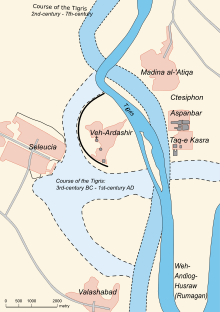
Back Ktesifon Afrikaans طيسفون Arabic ܩܛܝܣܦܘܢ ARC قطيسفون ARZ Ktesifon Azerbaijani تیسفون AZB Ктезифон Bulgarian তিসফুন Bengali/Bangla Ktesiphon Breton Ktesifon BS
ܩܛܝܣܦܘܢ (Qṭēspōn) Κτησιφῶν | |
 Map of the metropolis of Ctesiphon in the Sasanian era | |
| Alternative name |
|
|---|---|
| Location | Salman Pak, Baghdad Governorate, Iraq |
| Region | Mesopotamia |
| Coordinates | 33°5′37″N 44°34′50″E / 33.09361°N 44.58056°E |
| Type | Settlement |
| History | |
| Founded | c. 120 BC |
| Abandoned | c. 800 AD |
| Site notes | |
| Excavation dates | 1928–1929, 1931–1932, 1960s–1970s |
| Archaeologists | Oscar Reuther, Antonio Invernizzi, Giorgio Gullini |
| Condition | Ruined |
Ctesiphon (/ˈtɛsɪfɒn/ TESS-if-on; Middle Persian: 𐭲𐭩𐭮𐭯𐭥𐭭, Tyspwn or Tysfwn;[1] Persian: تیسفون; Greek: Κτησιφῶν, Attic Greek: [ktɛːsipʰɔ̂ːn]; Syriac: ܩܛܝܣܦܘܢ[2]) was an ancient Iranian city, located on the eastern bank of the Tigris, and about 35 kilometres (22 mi) southeast of present-day Baghdad. Ctesiphon served as a royal capital of the Iranian empire in the Parthian and Sasanian eras for over eight hundred years.[3] Ctesiphon was capital of the Sasanian Empire from 226–637 until the Muslim conquest of Persia in 651 AD.
Ctesiphon developed into a rich commercial metropolis, merging with the surrounding cities along both shores of the river, including the Hellenistic city of Seleucia. Ctesiphon and its environs were therefore sometimes referred to as "The Cities" (Mahuza, Arabic: المدائن, romanized: al-Mada'in). In the late sixth and early seventh century, it was listed as the largest city in the world by some accounts.[4]
During the Roman–Parthian Wars, Ctesiphon fell three times to the Romans, and later fell twice during Sasanian rule. It was also the site of the Battle of Ctesiphon in 363 AD. After the Muslim invasion, the city fell into decay and was depopulated by the end of the eighth century, its place as a political and economic center taken by the Abbasid capital at Baghdad. The most conspicuous structure remaining today is the Taq Kasra, sometimes called the Archway of Ctesiphon.[5]
- ^ Kröger, Jens. "Ctesiphon". Encyclopædia Iranica. Retrieved 12 December 2016.
- ^ Thomas A. Carlson et al., “Ctesiphon — ܩܛܝܣܦܘܢ ” in The Syriac Gazetteer last modified July 28, 2014, http://syriaca.org/place/58.
- ^ "Ctesiphon: An Ancient Royal Capital in Context". Smithsonian. September 15, 2018. Retrieved 2018-09-21.
- ^ "Largest Cities Through History". geography.about.com. Archived from the original on 18 August 2016. Retrieved 25 November 2015.
- ^ Eventually no less than four Sasanian rulers were quoted as its builders: Shapur I (241–273), Shapur II (310–379), Chosroes I Anushirvan (531–579) and Chosroes II Parvez (590–628). Kurz, Otto (1941). "The Date of the Ṭāq i Kisrā". The Journal of the Royal Asiatic Society of Great Britain and Ireland. (New Series). 73 (1): 37–41. doi:10.1017/S0035869X00093138. JSTOR 25221709. S2CID 162160996.
